
Illustration of tree, cones, and foliage [Matt Strieby, 2020].

Drawing of the largest recorded noble fir, on Yellowjacket Creek [Robert Van Pelt] (Van Pelt 1996).
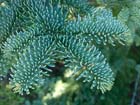
Typical sun foliage, showing quadrangular needles with stomata on all surfaces; axillary buds will form pollen cones [C.J. Earle, 2008.09.07].
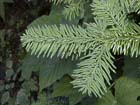
Typical shade foliage, showing a line of decurrent leaves above a layer of 2-ranked leaves [C.J. Earle, 2003.08.24].
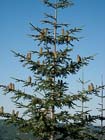
Crown, showing typical placement of seed cones (Mt. St. Helens, WA) [C.J. Earle, 2008.09.07].
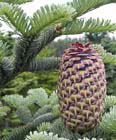
Nearly mature seed cone showing exserted bracts that nearly cover the fertile scales [C.J. Earle, 2010.06.26].
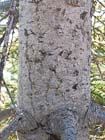
Bark on a sapling 15 cm diameter [C.J. Earle, 2008.09.07].
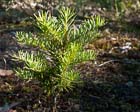
A seedling 12 cm tall [C.J. Earle, 2008.09.07].
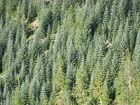
Dense mixed regeneration, dominated by the blue-green crowns of A. procera, within the blast zone at Mt. St. Helens [C.J. Earle, 2008.09.07].
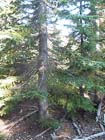
Tree at Mt. St. Helens (Meta Lake). Dense branching and short internodes near the middle of the photo show the tree's height at the time of the May 1980 eruption, which the tree survived because it was buried under the snow. Long internodes at top of the photo show rapid growth release (beginning about 3 years post-eruption) in response to complete removal of the overstory by the volcano's blast [C.J. Earle, 2011.09.24].


Abies procera
Rehder 1940
Common names
Noble or red fir, larch (Peattie 1950).
Taxonomic notes
Syn: Abies nobilis (Douglas ex D. Don) Lindley 1833, not A. Dietrich 1824 (Hunt 1993). Extensively hybridizes with A. magnifica in northern California; see discussion under Abies magnifica.
Description
Trees to 80 m tall and 220 cm dbh; "crown spirelike. Bark grayish brown, in age becoming thick and deeply furrowed (furrows and ridges about same width) and reddish brown (especially reddish when plates flake off). Branches diverging from trunk at right angles, stiff; twigs reddish brown, finely pubescent for several years. Buds hidden by leaves, tan, ovoid, small, not resinous, apex rounded; basal scales short, broad, equilaterally triangular, pubescent centrally, not resinous, margins entire to crenate, apex sharp-pointed. Leaves 1-3(3.5) cm × 1.5-2 mm, 1-ranked, flexible, proximal portion often appressed to twig for 2-3 mm (best seen on abaxial surface of twig), distal portion divergent; cross section flat, with prominent raised midrib abaxially, with or without groove adaxially, or cross section 4-sided on fertile branches; odor pungent, faintly turpentinelike; abaxial surface with 2-4 glaucous bands, each band with (4)6-7 stomatal rows; adaxial surface bluish green, with 0-2 glaucous bands, each band with 0-7 stomatal rows at midleaf; apex rounded to notched; leaves on fertile branches 4-sided with 4 bands of stomates below; resin canals small, near margins and abaxial epidermal layer. Pollen cones at pollination ± purple, ± red, or reddish brown. Seed cones oblong-cylindric, 10-15×5-6.5 cm, green, red, or purple, overlaid with green bracts, at maturity brown (bracts light-colored and scales dark), sessile, apex rounded; scales ca. 2.5×3 cm, pubescent; bracts exserted and reflexed over scales. Seeds 12 × 6 mm, body reddish brown; wing slightly longer than body, light brown to straw; cotyledons (4)5-6(7). 2n=24" (Hunt 1993).
Hunt (1993) discriminates A. procera from A. magnifica according to this key:
| Basal bud scales pubescent throughout; seed cones 15-20
cm, bracts included or exserted; adaxial surface of leaves usually
without longitudinal groove. |
A. magnifica |
| Basal bud scales pubescent centrally, glabrous at
margins; seed cones 10-15 cm, bracts exserted; adaxial surface of
leaves usually with longitudinal groove. |
A. procera |
Distribution and Ecology
USA: Washington, Oregon and California at 60-2700 m elevation in mixed conifer forests (Hunt 1993). See also Thompson et al. (1999). Hardy to Zone 5 (cold hardiness limit between -28.8°C and -23.3°C) (Bannister and Neuner 2001).
Distribution of Abies procera (green), A. magnifica (red), and A. magnifica var. shastensis (orange). Data from USGS (1999).
This species is unusually wind-firm, moderately shade-tolerant, not fire-tolerant, but does extremely well in high-light situations. Thus it tends to occupy distinctive locations on the landscape, and to be a very effective competitor in places that provide suitable conditions. These include uncommonly windy situations, such as in the Columbia River Gorge or on exposed montane and subalpine ridges. A. procera also prospered following the eruption of Mt. St. Helens in 1980 (photos at right). The blast associated with the eruption denuded the landscape over a large area primarily north to east of the mountain, but many A. procera seedlings and saplings survived the destruction because they were protected under the dense snow cover existing at the time (mid-May). Within a few years these trees had set seed and now A. procera is widespread on suitable sites within the blast zone.
Remarkable Specimens
This species contains the largest trees ever recorded in Abies. The largest and tallest specimens are found in the valleys southwest of Mt. St. Helens in Washington; comparable trees formerly existed north of Mt. St. Helens as well, but were destroyed in the eruption of May 18, 1980. The area still contains many extraordinary trees, at one time including the tallest Pseudotsuga menziesii in the state; nearly all of the area has been logged, though, and even larger trees may have been here at one time. The abundant rainfall and deep volcanic soils, coupled with a long fire-free history, may account for the unusually tall trees, the tallest known in the Washington Cascade Range. Currently the largest known noble fir is a tree 82.9 m tall and 253 cm dbh, with an estimated stem wood volume of 126 m3; it grows in the Goat Marsh Research Natural Area near Mt. St. Helens in Washington (Van Pelt 2001; data have since been confirmed several times and in 2021 the tree is known to be healthy). The largest specimen ever recorded was 72.6 m tall, dbh 275 cm, crown spread 12.5 m, stem volume 174.3 m3 when measured in 1988; also in the Goat Marsh Research Natural Area (Van Pelt 1996). This tree died in, probably, 2009 (R. Van Pelt email 2012.10.12).
The tallest known trees also grow in this area; using LIDAR data, Michael Taylor (email 2022.04.18) has identified the 50 tallest, all found in Goat Marsh or nearby, with heights all over 79 m. The tallest tree is 83.91 m tall. Although this is impressive, the height of the tallest tree has declined over time. In 1989 the tallest tree at Goat Marsh was 89.9 m tall, dbh 192 cm, crown spread 13 m, stem volume 87.7 m3 (Van Pelt 1996). The tallest one ever measured, and the tallest tree of Abies ever recorded, was 99.06 m tall. It grew near Harmony Falls northeast of Mt. St. Helens. The forest in that area was destroyed in the 1980 eruption (Van Pelt 2001).
The oldest known specimen is documented in a tree-ring chronology covering the period 1653-1976 (crossdated after 1748), collected on the southwest flank of Mt. St. Helens, Washington, USA by Linda Brubaker (doi.org/10.25921/ztd5-tn59). The oldest tree in the study provided a 324-year record. It was living at the time, but the area was obliterated in the volcano's 1980 eruption. Only two tree-ring collections of this species are recorded and substantially older trees may occur.
Ethnobotany
The wood was formerly used for airplanes and ladders, in both cases because it is light, strong and can be bent far before breaking. It is still regarded as one of the best true firs for lumber due to the strength of the clear, lightly grained wood.
The species has seen some use in dendrochronology. Applications have included stable isotope analysis to infer climate variation, single-year calibration of the radiocarbon time scale, forest structural change in response to windthrow, and forest decline due to volcanic ash deposition.
Observations
The Goat Marsh RNA stand, mentioned above, is well worth a visit. Some fine stands can be found in Mount Rainier National Park.
Remarks
This species is aptly named, for it is probably the largest of all Abies in terms of diameter, height and wood volume. It was first found by fabled botanist-explorer David Douglas, growing in mountains on the north side of the Columbia River Gorge, where exceptional stands can still be found. It loves windy sites because it is one of the most windfirm trees, swaying grandly in even the most howling gales of winter.
Citations
Rehder, A. 1940. Abies procera, a new name for Abies nobilis Lindl. Rhodora 42:522-524.
See also
Elwes and Henry 1906-1913 at the Biodiversity Heritage Library (under the name Abies nobilis) (Photo). This series of volumes, privately printed, provides some of the most engaging descriptions of conifers ever published. Although they only treat species cultivated in the U.K. and Ireland, and the taxonomy is a bit dated, still these accounts are thorough, treating such topics as species description, range, varieties, exceptionally old or tall specimens, remarkable trees, and cultivation. Despite being over a century old, they are generally accurate, and are illustrated with some remarkable photographs and lithographs.
FEIS database.
Farjon, Aljos. 1990. Pinaceae: drawings and descriptions of the genera Abies, Cedrus, Pseudolarix, Keteleeria, Nothotsuga, Tsuga, Cathaya, Pseudotsuga, Larix and Picea. Königstein: Koeltz Scientific Books.
- Provides a detailed account, with illustrations.
Liu (1971).
Maze and Parker (1983).










